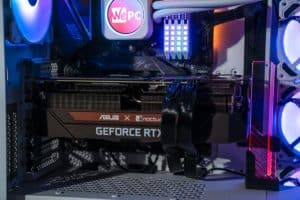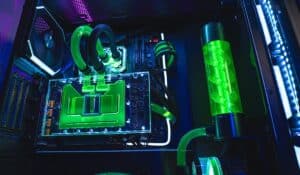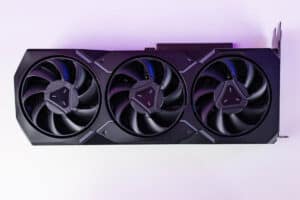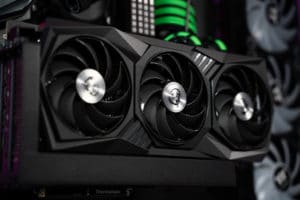Gaming Graphics & Optimization | What Settings Affect Performance The Most?

WePC is reader-supported. When you buy through links on our site, we may earn an affiliate commission. Prices subject to change. Learn more
The quality of gaming graphics over the last 10 years has improved exponentially, providing users with new levels of realism that are hard to differentiate from life itself. Whilst this is great for people using high-end gaming PCs, it isn’t so appealing for individuals on more budget-focused alternatives. For the latter, stunning game graphics are seen through jittering screens, torn images, and unsmooth gameplay – making the whole experience hugely frustrating, to say the least.
For the less-fortunate gamers out there, we’ve decided to compile this comprehensive guide that, for the most part, explains which game graphics are most demanding on your hardware. Using this guide will enable you to pinpoint which graphics settings are affecting your performance the most, hopefully resulting in a smoother, better gaming experience. Gaming graphics aside, we’ll also be taking a brief look at the components that affect gaming performance the most, and how to best spend your money when trying to boost FPS.
So, with all that in mind, let’s waste no further time and dive straight into it!
Game Settings That Affect Performance The Most
For a lot of gamers, gaming graphics can be extremely confusing. Most modern games come with a whole plethora of settings that can be tweaked to make individual aspects of the game’s graphics change. Annoyingly, it’s very difficult to see what those differences are by trial and error.
Fear not though, whilst this article won’t cover every graphics setting available (some just aren’t worth discussing – brightness for example), it will talk through some of the more technical settings and how they increase the demand on your system’s hardware.
Resolution
Resolution is one of the most performance damaging settings there is. Simply changing it from 720p to 900p can have a substantial effect on your FPS output.
The resolution of a game refers to how many physical pixels are being output to the monitor at any one time. A resolution of 1920 x 1080 is physically showing 1920 pixels horizontally by 1080 pixels vertically. So, when you move up to the next resolution on the ladder, you are giving the GPU and CPU more pixels to process – therefore having a huge knock-on effect on your FPS.
For the best results, you want to match the game’s resolution to your monitor’s native resolution. However, depending on the overall demand of the game vs your PC’s performance levels, it isn’t always possible to match the resolutions up.
As a whole, the resolution is one of the most performance affecting settings there is. Lowering the resolution of your game will see positive impacts on your FPS. Just remember, it’ll also have a negative impact on picture quality.
Anti-Aliasing
Next up, we have Anti-Aliasing. Whilst most games offer this in their graphics settings, not many gamers actually know what it does or how impactful it can be on their system.
Anti-aliasing is a graphics filter that smooths out rough/jagged edges that occur within your game’s graphics. Cranking up the Anti-aliasing in-game can make things look much smoother, however, you do pay the price when it comes to performance.
Like any graphics setting, anti-aliasing comes in a number of different levels which vary in terms of how performance-sapping they can be. The most popular (and how impactful they can be) are listed below:
- FXAA (Fast Approximate Anti-aliasing): This is the least harmful to performance levels. It affects your GPU performance slightly, but nothing that is overly noticeable.
- MSAA (Multisampling Anti-aliasing): This version of AA is smarter and less system-intensive than other versions. Instead of applying itself to the entire frame, MSAA only performs on the jagged part of the frame. This level of AA does start to put a decent amount of strain on your GPU.
- PhysX: This is Nvidia’s physics rendering setting that can be applied to a small part of the game frame. It adds a level of detail and realism that isn’t found on the other AA alternatives. That said, if you don’t have an Nvidia GPU, this can be extremely taxing on your PC. It can also affect your CPU quite dramatically as well. Turning this off can be an easy way to gain extra frames.
Supersampling
Sometimes seen in the Anti-aliasing bracket, supersampling can be a setting of its own in some games. Supersampling is a way of rendering the game to a resolution that is above the native resolution of your monitor. So, for example, you could supersample a 4K resolution onto a 1080p monitor.
Whilst this is a great feature for some individuals, it can be extremely taxing on your system’s hardware – especially the GPU. This would be one of the settings I’d switch off if I was trying to gain FPS.
Volumetric Lighting/Fog
Volumetric light – otherwise known as god rays -is a technique used in games to add lighting effects to a rendered scene. Ultimately, it allows beams of light to be rendered through a three-dimensional medium such as steam, fog, dust, or smoke, to provide a much more realistic final product. Another example of volumetric lighting is seeing light beams stream through a window – also known as crepuscular rays.
Whilst this feature looks fantastic when utilized in the right way, it can pose a real threat to your PC’s performance. Switching it off will see a decent rise in FPS, however, for immersion and realism, I’d try to keep it on.
Shadows
Shadows can be one of the most system-taxing rendering effects you can apply to a game. For the most part, they do pretty much what they say on the tin, render shadows that are created by the light within a scene. A large chunk of modern titles do offer shadow detailing in their settings. And whilst turning them on can make a scene look much more realistic, it can have a pretty steep knock-on effect with performance.
Lighting
Ingame lighting can, again, be hugely impactful to your game’s performance levels. Lighting consists of a number of different factors that range from the luminescence provided by the moon to the fall-off found from candle-lit scenes.
Changing the light settings through the various options adds and removes certain elements of the game’s graphics. So, when set to ultra settings, the game may show light being emitted from the moon. However, in medium, this rendering feature is completely taken away.
Lighting also includes global illumination, a feature that affects how accurately light bounces around the virtual world. Whilst this further increases the realism of your gaming experience, users can see large drops in FPS if cranked right the way up.
Ambient Occlusion
Whilst we’re on lighting and shadows, we may as well touch on ambient occlusion. This is a form of shading and rendering that calculates how individual surfaces are affected by the ambient light in the scene. So, if you have the sun shining through the window of a room, you may have some ambient light bouncing off the walls onto other surfaces. The end product is a non-directional shading effect that dims a scene without casting any clear shadows.
Despite this effect being fairly subtle in nature, it can have a large impact on your system’s performance. We would recommend dialing this down if you’re struggling for FPS.
Draw Distance
Draw distance affects the graphics of your game in the same way level of detail does, only on distant objects. Increasing the draw distance of your game increases the complexity and fidelity of distant objects, giving them much more accuracy and realism. Whilst the immersive value of this setting can not be denied, it does take a real toll on your system, especially when cranked up to its max level.
I would prioritize draw distance after resolution and AF (Anisotropic Filtering) settings, making sure you find a happy middle-ground between immersion and FPS performance.
The Best Upgrade To Get Better Performance
So, let’s say you’ve adjusted all the above settings and you’re still struggling to get 100FPS in your favorite gaming title? What’s the next step towards better gaming performance?
Well, if tuning the settings doesn’t work, the next logical step (apart from overclocking your components) is to upgrade on your system’s hardware. That being said, not every component will give you the desired in-game performance gains you require. So, what’s the best upgrade to get better performance?
Graphics Card Upgrade
The single best upgrade you can purchase (for most games) is a new GPU. The graphics card handles all the major graphics rendering that is seen in a game – upgrading it to something more powerful is a sure way to increase frames – unless you are bottlenecked by your CPU.
Below, we’ve listed some of the best GPU upgrades for different price ranges;
Low-End:
A sub $200 GPU which should increase 1080p FPS to around 60-100 in most popular gaming titles.
Mid-Range:
Middle of the road GPU for both price and performance. It offers up decent 100+FPS in most games and will get you into 1440p resolution territory.
High-End:
Whilst this isn’t the most powerful GPU out there (2080Ti is), it still offers up fantastic performance, bringing well over 100fps in most titles at 1440 and some 4k gaming that other cards can’t provide.
Conclusion
So, there you have it guys, our comprehensive rundown of some of the most demanding graphics settings and how they affect your game. Despite only choosing a few graphical settings, these are the most demanding in terms of your system’s performance. Many of the other settings found in numerous games don’t apply half as much pressure on your components. For that reason, we left those settings up to you.
That being said, we hope this article has answered some of the questions you have surrounding game settings. If you have any questions you’d like us to answer on this particular topic, feel free to drop us a comment in the section below, or head on over to our Community Hub instead!














